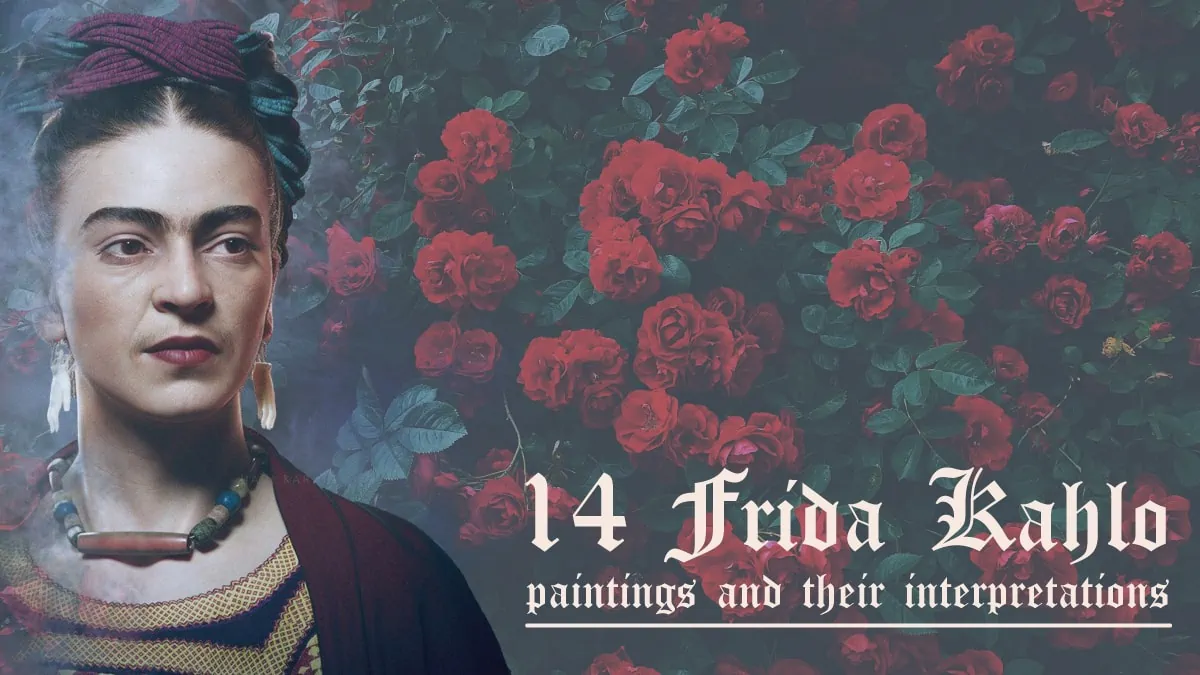Table of contents
- 1. Self Portrait in a Velvet Dress, 1926
- 2. Frida and Diego Rivera, 1929
- 3. Self Portrait on The Borderline Between Mexico and The United States, 1932
- 4. Henry Ford Hospital (The Flying Bed), 1932
- 5. A Few Small Nips (Passionately In Love), 1935
- 6. Memory (The Heart), 1937
- 7. The Suicide of Dorothy Hale, 1938
- 9. Self Portrait with Thorn Necklace and Hummingbird, 1940
- 10. Self Portrait as a Tehuana, 1943
- 11. Broken Column, 1944
- 12. Without Hope, 1945
- 13. The Wounded Deer, 1946
- 14. Marxism Will Give Health To The Sick 1954
- Over To You
- FAQs
Magdalena Carmen Frida Kahlo y Calderón – oh wait! Was that the name?
How about if I said I was talking about the famous Mexican painter, the Frida Kahlo.
Relatively unknown until the late 1970s, today, Frida is not only one of the famous painters but also an iconic figure for Chicanos, Feminism, and LGBTQA+ movements.
Frida Kahlo paintings mixed Mexico’s popular culture and a naïve folk-art style that questioned identity, postcolonialism, gender, class, and race.
Time and interpretation of varied paintings by Frida Kahlo have made her an unforgettable painter in the history of art.
Frida once said, “Painting completed my life.”
To celebrate her biggest pride, we present 14 Frida Kahlo paintings and the meanings that they hold.
Note: The paintings of Frida Kahlo are set chronologically. It will help you understand each painting vis-a-vis the events in her life. Original Frida Kahlo paintings also serve as a story of her life for most art historians.
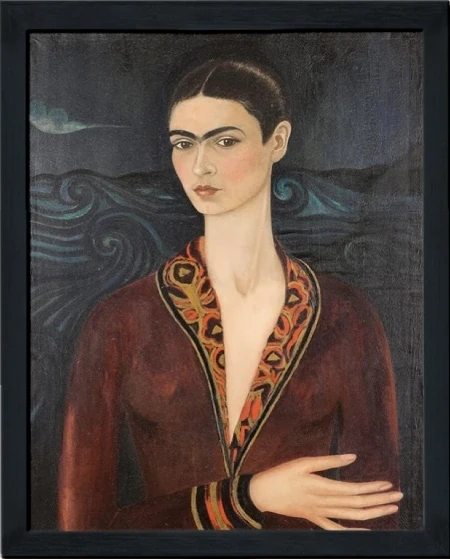
1. Self Portrait in a Velvet Dress, 1926
Known to be Frida Kahlo’s first attempt at portrait paintings, Self Portrait in a Velvet Dress was painted in 1926.
This painting came out as a result of a breakup with her then-boyfriend, Alejandro Gómez Arias, who considered her to be extremely liberal.
It was an attempt to convince him to love her back and win his affection again.
Image: pinterest by etsy
“I implore you to put it (the painting) in a low place where you can see it as if you were looking at me.”
Frida in a letter to her beloved.
Frida’s Velvet Dress Interpretation
In this famous Frida Kahlo painting, we see her portrayed waist up in a classical position of European Royalty. She has clothed herself in a red velvet dress with her right hand raised and a straight look coming right out of the painting.
The strong gaze of the painting combined with her elongated neck and fingers will keep coming back in Frida Kahlo’s Self Portrait of later life too.
The background is heavy with water storms and rolling waves against a pitch black sky which she claims to be symbols of life.
Frida Kahlo painted this portrait the year after her disabling bus accident which left her crippled for a while.
The storms and waves can be a hint of the ups and downs of life. It could have alternatively also been a way to tell that relationships are meant to be turbulent.
The painting is a mix of relative realism of her self-portrait and contrasting background painted in a naïve folk style.
A self-taught style of painting that Frida was beginning to adopt will soon play a huge role in all Frida Kahlo paintings, especially her self-portraits.
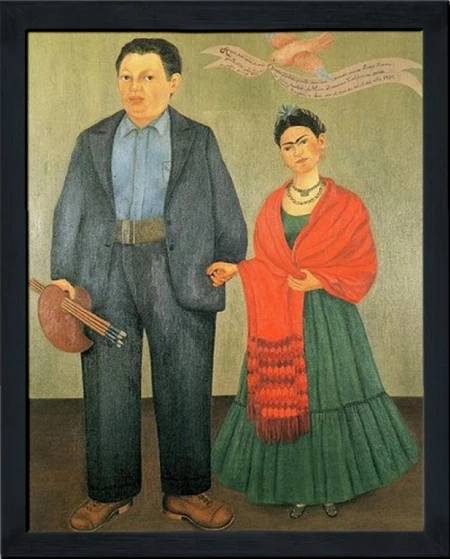
2. Frida and Diego Rivera, 1929
By the year 1927, Frida was finally able to go back and socialize with her friends, who had now started their university. She soon joined the Mexican Communist Party, which brought her between eminent artists and activists.
That is when she met the famous and well-known artist Diego Rivera who was then 42.
With sparks flying between the two of them, they finally confirmed their relationship and got married.
Frida and Diego Rivera, a famous painting by Frida Kahlo, was not a witness to their conjugal affair but much more than an aesthete could interpret.
Image: dawn
Frida and Diego Rivera Interpretation
With Frida and Diego, Frida Kahlo adopted a new painting style influenced by the traditional Mexican culture.
But what lies behind this happy painting of a couple is a striking balance of power within the relationship.
Frida knew that Rivera did not belong to any woman and was free from the restrictions of monogamy. With that hands held loosely, the painting shows how Frida was only one part of him.
This Frida Kahlo painting almost foresees the upcoming infidelity the couple was going to get involved.
In fact, Rivera was already having an affair with a tennis player named Helen Will when Frida was painting this portrait.
The painting also shows the influence of Cuernavaca, where she shifted after her wedding to Rivera.
Frida was so much in love with Rivera that she ignored her artistic strokes and focused on his detailing. Her love for him was not restricted to this painting, but she was also okay with him being an infidel.
She only wanted to be his best comrade.
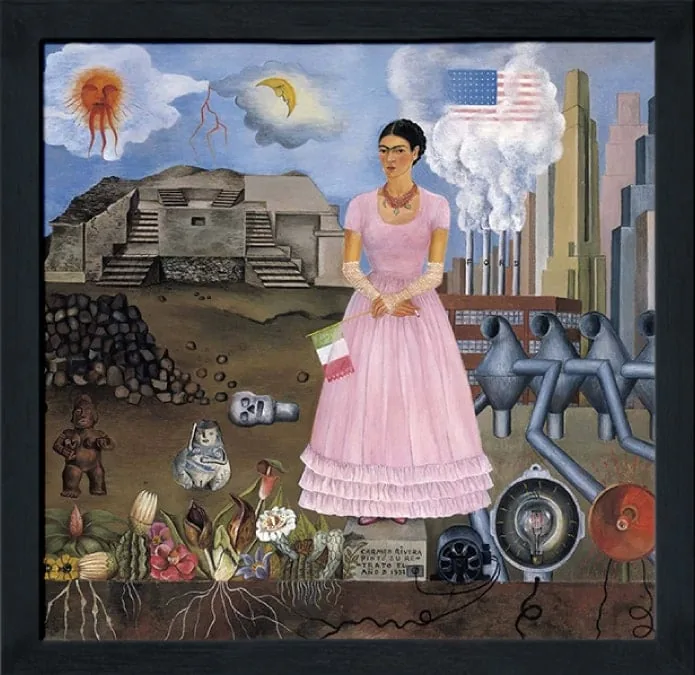
3. Self Portrait on The Borderline Between Mexico and The United States, 1932
A Self Portrait, also known as Frida’s Border Portrait, this 1932 painting was very different from her regular work of art.
While she was known for portraits that were born out of her personal life, this Frida Kahlo painting was, in fact, more political.
Mexico and USA border has become a defining issue for the current American Administration. Such a situation makes this painting all the more important for the history of Mexico.
This moment of Frida standing between the shared borders of America and Mexico is a statement in itself.
Image: Pixels
Frida’s Border Portrait Interpretation
Frida had become more social with time. From a timid young girl, her travels had made her more accessible in social gatherings. It can be clearly seen through her elegant dress, confident face, and the cigarette in her hand.
A flag of Mexico in her hand pointing downwards symbolizes her fealty to the fertile soil of her homeland. After her marriage to Rivera, they traveled to the USA and stayed there for almost three years. The drooping flag can also be one of the symbols of Frida feeling detached from her home roots.
The painting is divided into two halves. The first half in the bottom left corner stands as a symbol for Mexico.
It is one of those sections of the painting that uses a lot of symbols of fertility.
Soil bearing flowering fruits, the roots spreading across the underground. It is painted in hard tones of brown and yellow that speak of fertility.
But there is also a sheer contradiction symbolizing the cycle of life and death.
There is a clear utterance of the skull motif that implies death. The presence of the fire-breathing sun and the lonely moon has resulted in lightning.
This could also be an implication of the Jalisco earthquakes (in the same year) which destroyed much of Mexico’s architecture.
Interestingly, the fault line across the ground protrudes from Kahlo’s body, suggesting that the crack is, in fact in her own mind.
It can be her two-divided self, serving as friction, as a correlative for her relationship with her husband.
On the other hand, the USA has an air of industrialization.
There is dark and light here too. But it also includes electricity, industrial clouds, phallic towers, and flowers with electronic megaphones.
If looked closely, the electrical cords meet and intertwine with the natural roots of the Mexican vegetables.
Kahlo suggests that American industrialism, which her husband celebrated in his murals, was infecting the rich soil of Mexico.
To interpret it more personally, one could say that modernized America was Rivera, and Mexico was Frida.
That Rivera was seeping his industrialized roots into the fertile being called Frida. The portrait of her in the middle was nothing but her divided mind which didn’t know which side to fall.

4. Henry Ford Hospital (The Flying Bed), 1932
One of the most emotionally disturbing Frida Kahlo paintings is the Henry Ford Hospital.
Painted in 1932, it was the year when Frida had undergone a miscarriage.
It was a torturous year for the artist, considering she had just found out about Rivera’s extramarital affair with her sister, Cristina.
The only hope that kept her grounded was her and Rivera’s son.
But that very year, she had to be rushed to Henry Ford Hospital due to her miscarriage.
This painting by Frida Kahlo was also one of the first to have a metal frame used by many Mexican artists.
Regarded as one of the most symbolic pieces of art, Henry Ford Hospital has been cherished for years for the vivid description of the turbulence.
Image: twitter, FridaKahlo
Henry Ford Hospital Painting Interpretation
In this painting, we see Frida lying naked on the hospital bed in a pool of blood.
Her face is turned towards the viewer, but her lower body is moving away as if expressing helplessness.
There is one tear in her eyes as an indication of what had happened.
Six vein-like ribbons come out of her abdomen, looking like umbilical cords with each end tied to an object.
A fetus is attached to one of the cords that resemble the son Frida lost.
The rest seemed to be the objects in her vicinity when she was admitted to the hospital.
However, each object has its symbolism in Frida’s life.
For instance, the flower is an orchid that does not only indicate a token of “Get well soon” from Rivera. If we look closer, it is a fallen flower that stands as a symbol of her fallen womb.
The snail in this Frida Kahlo painting can be interpreted as the period of the operation. Although the operation did not take a lot of time, for Frida, it was as if years had passed.
Other objects like the pelvic bone signify Frida’s hip’s distorted and damaged condition.
This is one of Frida Kahlo’s best paintings to have ever used symbolism in such a clear manner. The heavy symbolism makes it one of the most studied and analyzed painting pieces in Fine Art Colleges.
Frida Kahlo wanted to see the dead fetus in order to paint him but was not allowed to do so. She eventually ended up painting an imaginative fetus from what Rivera described him as.
Did you know?

5. A Few Small Nips (Passionately In Love), 1935
Also known as Passionately in Love, this painting by Frida Kahlo seemed like another torturous artwork.
Post her miscarriage, Frida could hardly come up with any impactful paintings, mostly because of her mental instability.
It was only in 1935 when she finally painted A Few Small Nips.
The painting expresses passionate anger in such a horrifying way that it could almost be classified as a distressed painting.
It was upsetting to see a painter like Frida Kahlo in a state of mind to be able to create a painting of such gravity.
So much so that she had to use another woman as a cataclysm for her reflection.
Image: arthive
A Few Small Nips Interpretation
In this painting, we see a naked woman lying on the bed, soaked in blood, with her killer standing right in front of her.
There is a striking resemblance between how the woman lies and how Frida painted herself in Henry Ford Hospital.
The painting was a direct scene from the news about a man who smashed his girlfriend to death by continuously stabbing her with a knife.
During the trial, the murderer exclaimed, “But I just gave her a couple of nips.”
Frida found the story very fascinating and worthy of being painted. Her painting was also greatly inspired by printmaker Jose Guadalupe Posada, known for his newsworthy prints.
This painting of Frida Kahlo can be a great reflection of the “little nips” that Rivera had given her for years.
She was able to empathize with how it felt to be stabbed by one’s own partner.
“If I loved a woman, the more I loved her, the more I wanted to hurt her.”
My Art, My Life: An Autobiography, Diego Rivera
This pretty much explains why Frida was a victim of Rivera’s nips.
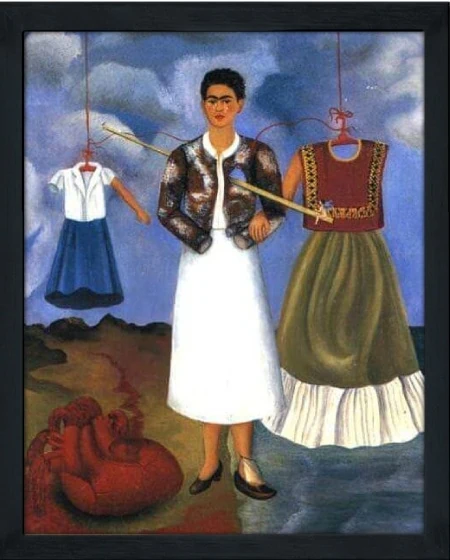
6. Memory (The Heart), 1937
Also known as Passionately in Love, this painting by Frida Kahlo seemed like another torturous artwork.
After meeting Rivera in 1927, the most famous Frida Kahlo paintings were based on her love, hatred, resentment, and eventual separation from him.
Memory (The Heart), painted in 1937, was yet another portrayal of how her heart was engrossed and affected by her thoughts of Rivera.
This painting was an expression of her misery and resentment over Rivera’s love affair with her sister Cristina.
The affair had not just taken away his comrade but also planted a seed of aversion towards her sister.
Image: wikipedia
Frida Kahlo’s The Heart Interpretation
This is one of Frida Kahlo’s self-portrait paintings where she looks dead straight into the viewer’s eye with no expression whatsoever.
Contrary to her facial expressions, she has uncontrollable tears coming down her eyes.
It was as if she had no possible expressions that could resonate with what she felt.
However, she also could not stop herself from crying.
Her hair is chopped into a boy cut, and she is wearing a rather European-style dress that makes her look less Mexican.
Post her separation from Rivera, she left Mexican styling and had become fond of European attires.
Like most of Frida Kahlo’s paintings, this painting also uses physical injuries to imply mental and emotional wounds.
Just how she shows her heart lying on the floor, which was cared less about, with rivers of blood gushing from it towards the back of the painting.
In the background is her school uniform and her favorite Tehuana costume, with each set having only one arm, and Frida standing there armless and helpless.
This implied that Rivera and Cristina, both her hands, were cut out of her body.
Her body seemed to be pierced by a steel rod with seesawing cupids on either end, which created an accurate visualization of the sensation of pain.
The foot put over the sea may have suggested the recent food surgery she was undergoing.
As complex as it seems, the painting delivers a clear message: she was heartbroken and did not have the strength to express how she felt anymore.

7. The Suicide of Dorothy Hale, 1938
Regarded as one of Frida Kahlo’s most shocking and controversial paintings, The Suicide of Dorothy Hale was painted in 1938.
The protagonist of the painting was Dorothy Hale, an American showgirl who, after her husband’s death, slowly proceeded towards her doom.
With a few failed lover affairs and a failing career, Dorothy resorted to committing suicide. It was said that she jumped off from the window of her topmost room in her favorite dress.
Clare Boothe Luce, Dorothy’s friend and an admirer of Frida Kahlo, immediately commissioned Kahlo to paint a memorial portrait of their deceased friend to give this portrait to Dorothy’s grieving mother as a gift.
She presumed Frida Kahlo would paint a typical portrait of Dorothy, which her mother could hang over the fireplace. However, Clare was shocked and almost passed away as soon as she unwrapped the painting that Frida sent.
The painting surprised everybody with its gruesome details of the suicide process. It not only showed Dorothy falling down from the tower but also her lying on the ground in a pool of blood.
To add to the sourness, she wrote the words, “In New York City on the 21st of October 1938, at 6:00 in the morning, Dorothy Hale committed suicide by throwing herself from a very high window in the Hampshire House. In her memory […], this retablo was executed by Frida Kahlo.”
Image: The Artist Editorial
Suggested Read: Memorial Gifts
The Suicide Of Dorothy Hale Interpretation
This painting was not meant to be symbolic since it was a commissioned-based custom portrait.
However, it gives great insight into what Kahlo was dealing with in her personal life. It was the time when she had just separated from Rivera and was undergoing suicidal thoughts herself.
This could be one of the major reasons to have influenced her to depict the entire process of suicide skillfully. It can also be said that she did not only paint Dorothy Hale’s suicide but underwent the experience of same while painting it.
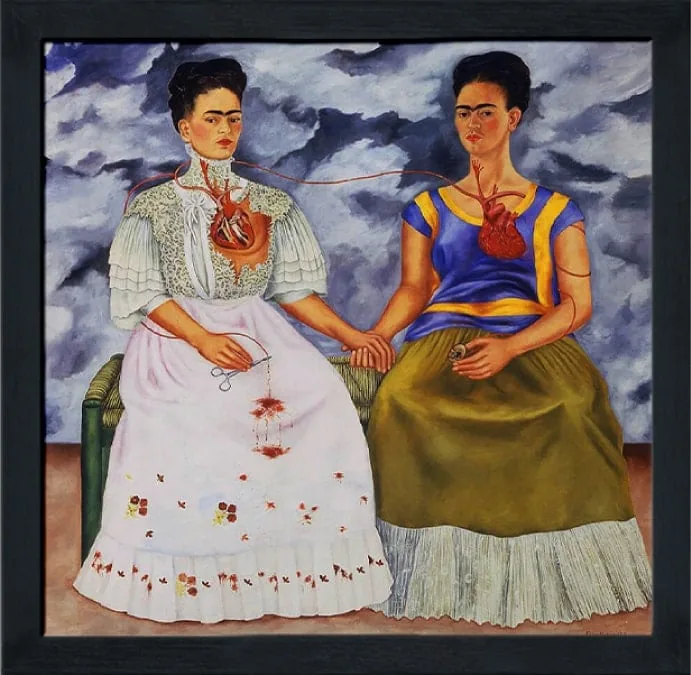
8. The Two Fridas, 1939
Also notably known as Frida Kahlo’s Standing Between Identities, this painting was painted in the year Frida, and Diego finally decided to part ways with a divorce. It was also the same year when Frida went to Paris for a solo exhibition in Andre Breton’s friend’s gallery, which became a turning point for her career.The Two Fridas is also one of the biggest self-portraits of Frida Kahlo.
Image: Khan AcademyDespite Kahlo and Rivera’s relationship being tumultuous, the couple remarried again after their divorce.
INTERESTING FACT
The Two Fridas Interpretation
In the painting The Two Fridas, we can see double subjects and both being Frida Kahlo. While those two were the same person, each had a characteristic of her own.
One was dressed in traditional Mexican attire and the other in a European outfit implying the two identities Frida had adopted.
In addition to that, the dresses were also a way for Frida to cover up the disability that she had faced in her childhood that led to her limping.
The two figures can also represent the fact that Rivera preferred Frida in the traditional dress, but Frida had changed herself into a more European appearance after their separation.
The hearts of The Two Fridas is connected with a thread that the European Dressed Frida (New Frida) cuts.
Frida was trying to make a statement with this painting.
It can be interpreted that the new Frida wanted to cut all ties with the old Frida but, at the same time, did not want to detach it completely. Despite the chords of the heart being detached, both the Frida are sitting holding hands.
The use of blood can represent the struggles and all the pain Frida went through during her lifetime, from being sick at a young age, experiencing a terrible vehicle accident, and miscarriage. This could show the two different personalities that make these two representations different, one being strong and one being weak and going through constant pain.
It were afterall these two Fridas that make that one true Frida. This painting can be Frida accepting herself with all the flaws and moving ahead in her life with both the Fridas.

9. Self Portrait with Thorn Necklace and Hummingbird, 1940
“My paintings carry with them the message of pain.”
Frida Kahlo
And this self-portrait of Frida Kahlo does exactly that; it speaks of her pain.
This was a relatively small painting compared to Frida Kahlo’s other paintings.
It was painted shortly after her relationship ended with Rivera.
Image: Wikipedia
Frida’s Thorn Necklace and Hummingbird Interpretation
This Frida Kahlo painting is a great depiction of her wounded with thorns penetrating her neck while her monkey and cat look at it.
The necklace is made of dead hummingbirds that can be interpreted as her depiction of herself.
As far as the painting is concerned, it just talks about how painful Frida’s life has been and all the things that she went through.
She had undergone 35 operations to function like a normal human being, and with a womb that could not bear fruits anymore, she was weakened internally.
This painting is but a depiction of all the hardship that she had to face after 8 years of age, making her the Frida who wore a thorned necklace.
To know more, read Frida’s Self Portrait with Thorn Necklace and Hummingbird (in-dept analysis).
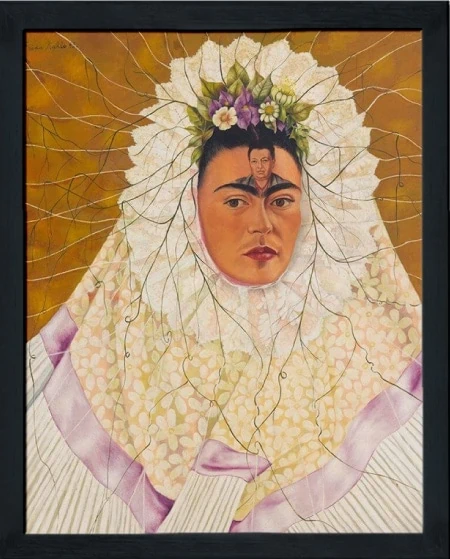
10. Self Portrait as a Tehuana, 1943
Another famous portrait Kahlo painted in 1943 was that of herself wearing a Tehuana dress.
The painting very evidently speaks of what has been going on in her mind for quite some time.
It had been a while after Frida and Rivera separated, but it was as if Frida could neither take him off her mind nor off her paintings.
Image: Arthive
Self Portrait as a Tehuana Interpretation
In this painting, we see Frida wearing a traditionally Mexican Tehuana costume. Let’s not forget that Rivera always admired Frida in traditional Mexican attires.
The painting seems to speak of Frida’s obsession with Rivera, who continued to betray her.
The miniature portrait of Rivera between her brows shows that he had been on her mind forever.
The spider web indicates that he is trapped in her mind like an insect stuck in a spider’s web.
Was it just another painting to make her way back to Rivera’s heart?

11. Broken Column, 1944
Yet another surgery, yet another pain, yet another painting.
If I could say, Frida added the “Pain” in “Painting.” But it is for this pain that she could tell her life story through her paintings; to show the world what it was to be a tortured artist and still fight against it.
This painting was made in 1944 when she had undergone spinal surgery, because of which she was bedridden.
Through this painting, she could tell the world how she felt about being tied to the bed for most of her life.
Image: Wikipedia
Frida’s Broken Column Interpretation
In the painting, she depicts herself constrained by a cage-like body brace—just a fleshless void exposing a column instead of her spine.
It is as if the column will just collapse and dismantle the body.
We can see nails piercing her entire body with a tear streaming down her face. In fact, even the backdrop of barren land shows the emotional intensity of the painting.
The imaginative scope of this painting will be later labeled as Surrealist Paintings seen in the works of Dali and the likes.
Kahlo was so exhausted from the numerous surgeries she went through that she had almost given up the idea of living altogether.
It was just the paintings that were now her hope.
Hope, a thing with feathers they say, but it meant something very different for Kahlo.
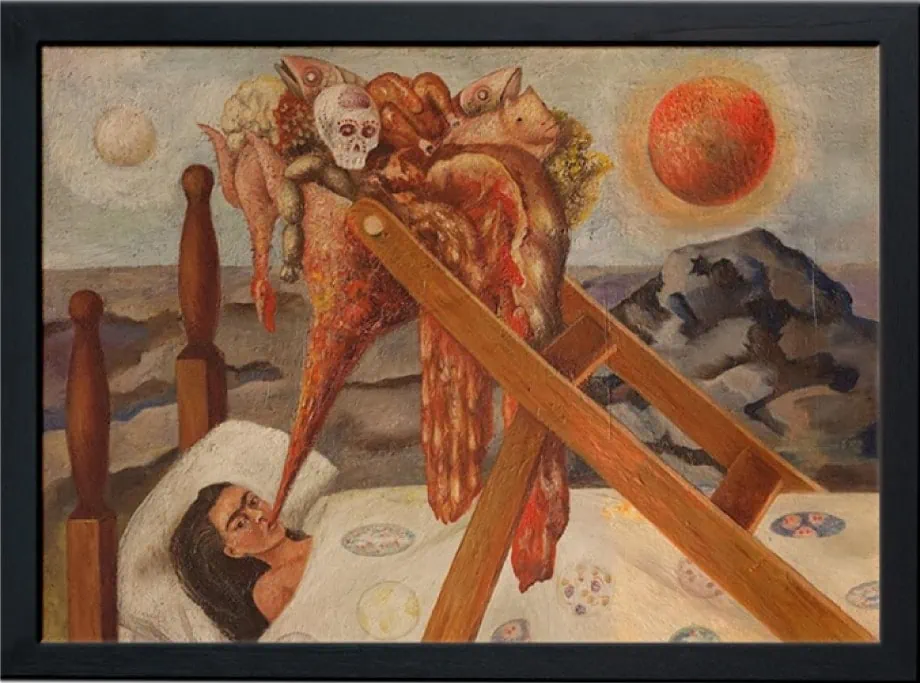
12. Without Hope, 1945
Painted in the year 1945, Without Hope is one of those paintings of Frida Kahlo that focused more on her physical illness and how it was affecting her mentally.
It was during this time that Kahlo completely lost her appetite due to the multiple surgeries that she went through.
She had become malnourished and weak by the time she was done with her last surgery and was recommended complete bed rest.
It was during that time that Frida painted this portrait.
Image: arthistoryproject
Without Hope Interpretation
The painting shows Frida lying on the bed with tears streaming down her eyes.
There is a pile of animal meat and a skull hung on top of the wooden frame that held her canvases. The meat apeear to be “forced fed” to her.
Since Frida started developing an eating disorder, she was fed fattening puree food every two hours.
Disgusted by the food and with the feeling of helplessness, she created this painting.
The backdrop remains of a barren Mexico with the sun and moon signifying that she has to remain like this across day and night.
The situation and the painting seem Without Hope.

13. The Wounded Deer, 1946
This painting was made in 1946. The same year, Frida went to New York for her spine surgery to relieve herself from the painting, but the surgery failed.
This painting was more of a disappointment towards that operation.
While she was hoping that she would be finally free from her wounds, she ended up getting more wounded.
There have been a number of interpretations of this painting by Frida Kahlo. Some say that it talks about her disappointment from the surgery, some say that it was Frida coming to terms with her fate, while there are others who think it has a sexual implication and hinted at her relationships.
Image: fridakahlo
Frida’s Wounded Deer Interpretation
According to what we think and as far as we can understand her then condition, it had to be a culmination of her frustration and her eventually giving into fate.
The painting shows the portrait of pet deer, Granizo’s body, painted on Frida’s head.
The body of the deer is pierced with arrows and is bleeding.
There is a note written in the lower left corner of the painting that reads “Carma” or “fate.”
Frida was known to have a lot of pets that she considered to be her surrogate children and painting a wounded child showed the intensity of despair that had come on her.
The backdrop is that of a forest with dead trees and broken branches almost instilling a sense of foreboding and fear.
There is a light at the end of the forest that promises bright days but the deer is too wounded to reach there.
As much as I want, I cannot ignore the fact that this painting was nothing but the depiction of the situation that fate has brought Frida to.
With so many operations and injuries, she was nothing but a Wounded Deer.
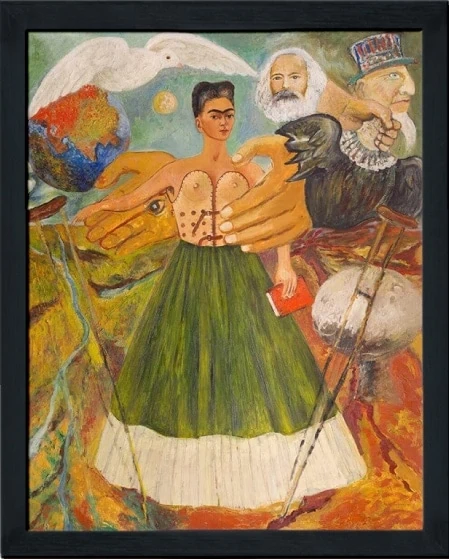
14. Marxism Will Give Health To The Sick 1954
Painted almost in the later years of her life when most the Mexico was heavily influenced by the Marxist theory.
To serve the party and uproar the Marxist Revolution she decided to include her political notions in her paintings.
Marxism Will Give Health To The Sick is one such example of Frida Kahlo paintings.
Frida’s Political Painting Interpretation
Frida had a life full of suffering but with the advent of Marxism, she started putting her trust in the revolution.
The painting shows Frida standing in a leather corset with her crutches thrown apart.
There are two hands, one supporting Frida to walk and the other strangling the neck of evil.
It clearly looks like Karl Marx’s hands, the visionary behind Marxism.
The painting is nothing but Frida’s belief that only her political affiliation to Marxism will free her from the pains and sufferings she has encountered in her life.
“For the first time, I am not crying anymore.”
Frida’s commented on her political painting.
This painting was one of her last portraits and still seems to be incomplete.
Image: Forbes
In Frida Kahlo Paintings Auction, her self-portrait Diego Y Yo has been sold for 34.9 Million at Sotheby’s Modern Evening Sale to become one of the most expensive paintings of Latin America.
.
Over To You
While Frida lived her life in suffering, she finally understood her calling in the final years.
In fact, Frida stands as a voice for not just all female painters but as a visionary who changed Mexican art.
From attending her first exhibition in an ambulance to becoming an inspiration for the coming-of-age artists, Frida has done more than necessary in her rosey way.
She remains one of the unbeatable figures of history, contributing to the richness of art.
With this, the story of Frida Kahlo and her paintings come to an end.
Attention Readers!
We have something that may interest you if you are a fine art lover.
As fanatics of art ourselves, we bring to you museum-quality art replicas of famous paintings.
Now be it Frida Kahlo or the paintings of Van Gogh, you can have their painted artworks to yourself.
Don’t believe me? Hit the button below.
I hope this piece helped you understand the major Frida Kahlo Paintings and their interpretations.
If you enjoyed this article, I recommend you to read my article, the Famous Cat Paintings.
I’ll take leave here.
Cheers!
Do know some interesting facts about Frida Kahlo?
Leave a comment below, and I will include them in my next article.
FAQs
Frida Kahlo was a surrealist painter and was famous for depicting realist artworks. She seems to bring the real emotions, elements, and composition that showcase her life and suffering.
Frida Kahlo’s paintings are recognized for their self-portraits, pain, and passion in bold, vibrant colors.
The most famous painting by Frida was The Two Fridas (1939).
Frida answered this question in one of his quotes that, “I paint myself because I am so often alone and because I am the subject I know best.”
Although she was not a feminist, her bold character, activism, and art made her a feminist icon.



